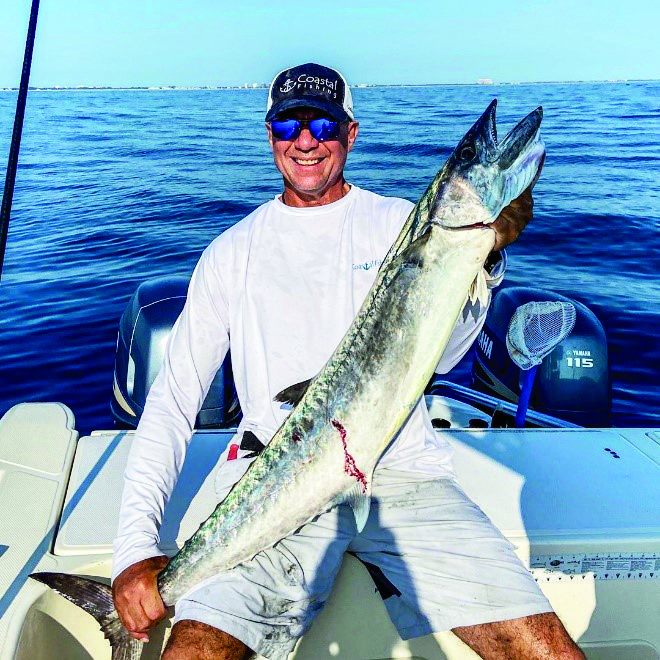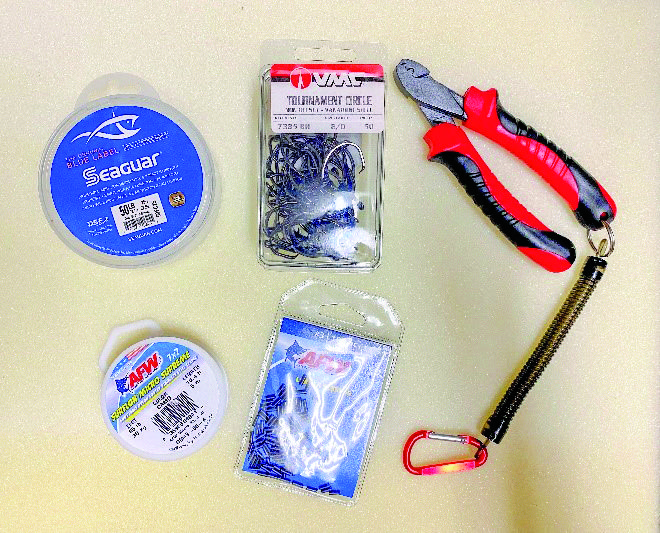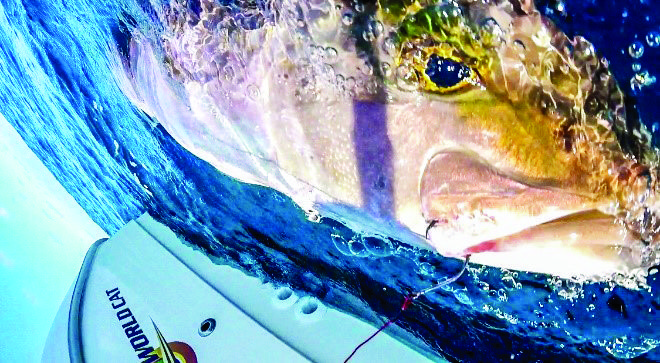By Mark Ambert Contributing Writer

My favorite time of year is here in Southeast Florida. You can feel the change in the air. The weather pattern has shifted and the fish sense it too. The cooler fall temperatures and prevailing winds begin to stack the bait up on the ledge bringing with it smoker kings, tuna, sailfish, and the elusive wahoo! Kingfish will typically run between twenty and forty pounds this time of year, with bigger fish out there as they migrate south. Targeting these larger fish requires some preparation and a strategy. For equipment, I like to use a large bait-runner style spinning reel like the Shimano 12000D attached to an appropriate 7’ boat style spinning rod. I prefer this setup over conventional for the quicker line retrieve and ease of handling around the deck and motors. When a big kingfish doubles back racing towards the boat you will want the fastest line retrieval possible to keep tension on the line and control of the fish.

Building a better mousetrap
Critical to success will be a finely tuned line and leader system. First line on the reel is the backing – I use Power Pro 50lb braid in Moss Green as the foundation for my line system. Spool as much as you can fit on your reel but leave enough room for at least a 50 yard “top-shot” of monofilament on the reel. This amount of mono will give just enough stretch and abrasion resistance to help prevent breakoffs. I use Momoi’s Hi-Catch Diamond 40lb in Clear for this purpose.
Leader -For finicky fish like tuna I use four feet of 50lb Seaguar Fluorocarbon. For the toothy critters I make a custom leader starting with 36” AFW Surflon Micro Supreme nylon coated 7×7 strand leader wire in 65lb Camo. The 36” length works well for preventing cutoffs due to contact with sharp body fins! I then attach a 100lb barrel swivel using a #3 AFW leader sleeve / crimp. On the business end I use VMC Tournament series circle hooks in size 8/0 also attached with a crimp.
For knots I use a Double Uni to make the braid to mono connection and the improved clinch knot to attach the barrel swivel to mono.
I like using this custom coated wire system better than single strand wire as it’s much softer and more flexible, doesn’t kink and seems to visibly disappear to the fish when in the water. It also allows the bait to swim more naturally. I’ve hooked sails, tuna, mahi, kings, and wahoo all using this same leader system and the bump-troll method described below. Bring extra pre-made leaders along with crimps and hooks as you can usually reuse a leader by cutting off the frayed end after landing a fish.

Starting the day -Targeting big kings, I start my morning just at first light and slightly north of Jupiter inlet on the ledge that runs north and south from Jupiter down past Juno pier. This same technique will work coming out of any inlet – you just need to locate the nearest ledge or drop-off. Target your starting point at 90 – 100’ of water and look for areas where the steepest drop-offs occur. Use your fish finder / plotter to look for contour changes that will put you in 120 – 140’ pretty quickly and zig zag the changes. Start by bump trolling one or two live baits slowly heading out to deeper water then back. When using two baits, stagger them by fishing one long and one shorter. Let the long line out first. If you are fishing alone, use only one bait. You will get plenty of bites when fished correctly and eliminate the risks associated with fishing two lines solo. I slow troll using only one motor at a time and taking it in and out of gear to produce the slowest possible movement over ledges, structure, bait balls and drop-offs. Taking the boat in and out of gear will raise and lower the bait in the water column – this is a deadly technique and works for all top predators. You can speed up to reposition on the structure but not too fast or you will drown the bait. I try to use the biggest bait possible as this minimizes the bonita bite and will definitely put you on the bigger fish. Big bait includes goggle eyes, mullet, sardines, and blue runners. Goggs and runners are my personal favorite as they are hearty fish that hold up well to bump trolling. Both these baits also like to swim for the bottom when the boat is in neutral covering more of the water column. I attach my baits to the hook using a rubber band and needle – your local tackle shop will be happy to help you with this setup as it’s better to be shown the “how-to” for the first time.
It usually doesn’t take more than a few minutes to hook up with a king this time of year with the occasional tuna, sailfish, mahi, or wahoo – a bonus! Look for areas and times when the tide is moving and when the baits are being balled up and swept along by stronger currents. These eddy’s usually form around structure such as ledges, drop-offs, and wrecks. You can usually see them forming on the surface. Look for birds, weed lines, or color changes to help identify these areas. Places without some form of moving water are usually wasted time. Your fish finder screen should be lit up with bait in the water column. If not – pick up and move until you find the bait — then hang on!
Pro Tip -If you find nice bottom structure or a wreck marking fish, don’t hesitate to drop a bait down on conventional tackle and a sinker rig after trolling a few times on the surface – lots of big amberjacks, barracuda, and grouper cruise these areas and are a definite bonus! Once the bait gets picked up count off three seconds and engage the reel. No need to set the hook using circles – just let the line come tight and fish on! I prefer a lighter drag setting to let these smoker kings run – you’re not going to stop a fish that swims at better than forty miles per hour! If sharks are a problem, start the boat and follow the fish close. One or two blistering runs and the fish will settle down. Ease them towards the boat and don’t horse them in. Apply enough pressure to bring them to the surface and with a well-placed gaff shot they will be one step closer to the smoker! The smaller ones can make excellent table fair if bled and iced down properly on the boat. Now that you’re ready to tackle these prized fighters – go out there and get some. The fall morning bite is red hot!
Mark Ambert – Avid Outdoorsman, sportswriter & photographer
“For me, fishing is a passion second to none. It sets the heart racing and soul on fire to be on the water and in the hunt.
For those few hours we can forget everything, and life unfolds like no place else. Always live your passion.”
